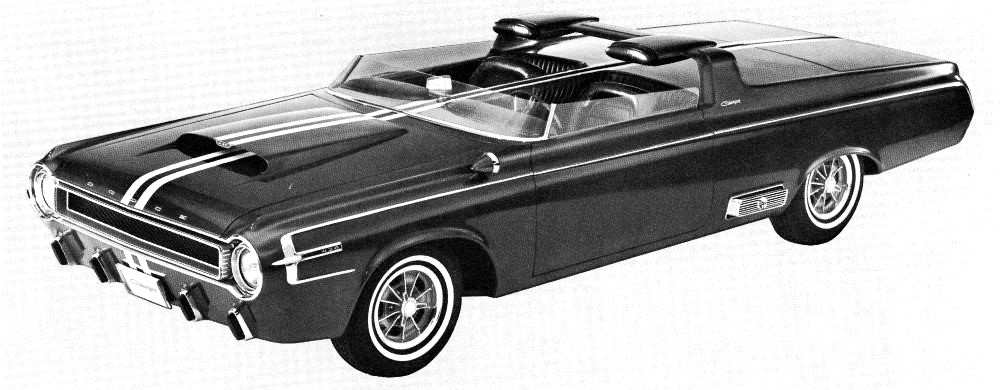
1964 Dodge Charger Concept Vehicle
Based on a two-door Dodge Polara, the 1964 Dodge Charger Concept Vehicle was a one-off, open-air roadster built to help introduce the company’s new hemispherical head performance engine, the 426 HEMI. With its low windshield line, separate driver and passenger cabins, integrated sport bar with headrest and bumper-less body, the handcrafted Dodge Charger Concept Vehicle was stunning.
At the time very few concept vehicles could actually be driven. Most were used as static design studies to gauge consumer reactions on the auto show circuit. However, the Dodge brand insisted on making the 1964 Dodge Charger a runner. With the company co-developing the HEMI engine with racing teams, very few hand-built HEMI prototypes were available. Due to an unfortunate incident with one race team’s engine blowing up, the Dodge Charger Concept Vehicle’s engine was given away. The actual engine powering the futuristic Dodge Charger was the original 383 cubic-inch V-8 heart from the donor Dodge Polara.

1965 Dodge Charger II Concept Vehicle (1965 Chicago Auto Show)
Designed to illustrate the advanced design direction of the Dodge brand, the 1965 Dodge Charger II Concept Vehicle debuted at the 1965 Chicago Auto Show. Foreshadowing the 1966 production model’s design cues, this one-off show car featured a clean fastback design with pronounced rear fins and rear overhang. While the car featured a pillar-less daylight opening, the prominent C-pillar extended rearward toward the tail lamps. Other key design features included pop-up headlights hidden behind a full-width radiator grill, four bucket seats and full-width rear tail lamps.

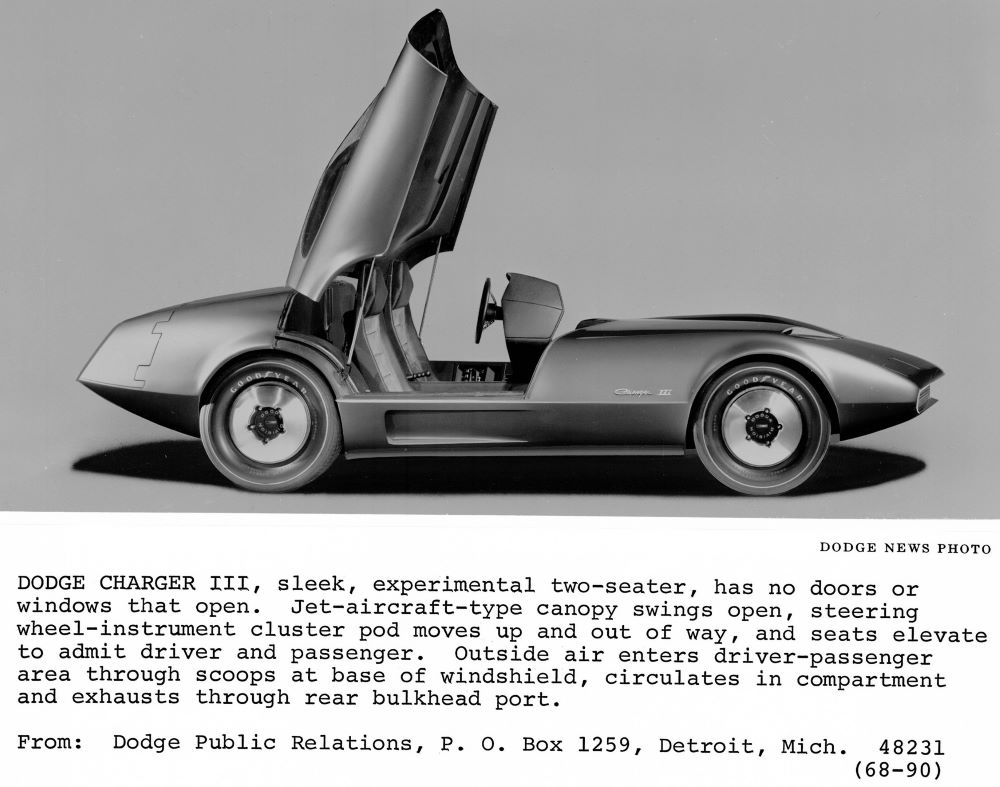
 1966 to 1967 (Generation: I)
1966 to 1967 (Generation: I)
The Dodge Charger was introduced on Jan. 1, 1966. Built off of the Dodge Coronet chassis but using its own body, the new Charger was the Dodge brand’s first production fastback, high-speed street racer. It featured many styling cues from the Charger II concept car, like a fastback roof design and full-width tail lamps. The interior featured four bucket seats and a full-length center console.
The first-generation Dodge Charger came with a standard 318 cubic-inch V-8 engine that delivered 230 horsepower. Other available engines included a 361 cubic-inch V-8 engine, which delivered 265 horsepower or a 383 cubic-inch V-8 engine that delivered 325 horsepower. However, it was the availability of the massive 426 cubic-inch “Street” HEMI V-8 engine that provided 425 horsepower and 490 lb.-ft. of torque that forever defined Dodge Charger as a performance car.
The HEMI V-8 engine was already a legend in the mid-1960s as Chrysler Corporation cars dominated NASCAR. However, in 1965 NASCAR banned the HEMI engine, as it did not follow the new guidelines mandating that engines had to be available for serial production. The company boycotted the racing season.
Minor updates were added to the Dodge Charger in 1967, including the addition of small front fender turn indicators and a vinyl roof option. Underneath the crisp two-door styling, a collapsible steering column and dual-system master cylinder became standard equipment to meet the arrival of U.S. Federal Safety regulations.
From the marketing perspective, the Dodge brand abandoned its “Join the Rebellion” theme and moved forward with a performance-oriented “Road & Track” theme.
The Dodge Charger was introduced on January 1, 1966. Built off of the Dodge Coronet chassis but using its own body, the Charger was Dodge’s first fastback, high-speed street racer. It featured many styling cues from the Charger II concept car like a fastback roof design and full width taillamps. The interior featured four bucket seats and a full-length floor console.
The vehicle came with a standard 5.2-liter, 318 cubic-inch V-8 engine delivering 230 horsepower. Other available engines included a 361 cubic-inch V-8 engine that created 265 horsepower, or a 6.2-liter, 383 cubic-inch V-8 engine delivering 325 horsepower. However, it was the availability of a massive 426 cubic-inch Street HEMI® engine that provided 425 horsepower and 490 lb.-ft. of torque that forever defined the vehicle.

AT THE TRACK… Chrysler Corporation cars dominated NASCAR in the mid-1960s with the mighty HEMI engine. In 1965, NASCAR banned the HEMI and Chrysler boycotted the racing season. Ultimately, Chrysler followed the new NASCAR rules mandating that engines had to be available in general production, not just for race cars as the HEMI had been. For the 1966 season, Chrysler made a Street HEMI that was used for both the street and the racetrack
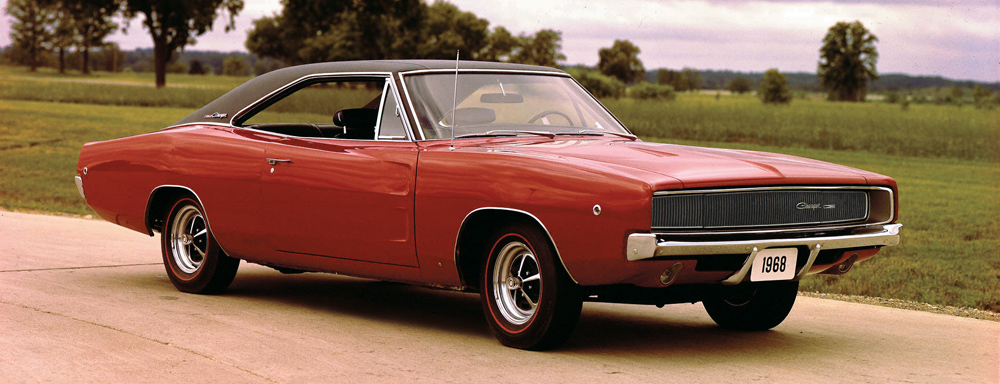
1968
1968 to 1970 (Generation: II)
The second-generation Dodge Charger arrived in 1968 with all-new styling. Dodge designers and engineers were tasked to create and develop a performance coupe that looked ready to race on Daytona’s high banks, but still be driven on the streets.
The result was an exterior design with a “double diamond” or horizontal “Coke bottle” silhouette, a reference to the new design’s muscular bulges above the front- and rear-wheel wells. Further enhancing the sleek design was a “flying buttress” or swept-back tunneled roof lines around the rear glass. Sculptural twin scallops on the hood and doors created more dramatic surfaces than most slab-sided vehicles of the era. Other notable design features included a contrasting vinyl roof and flip-top gas cap. Inside, the 1968 Dodge Charger’s all-new interior featured front bucket seats with an optional cushioned center console. Improvement in passenger safety and comfort included the addition of an energy-absorbing instrument panel and seats.
ON THE STREET… The Dodge Charger was completely restyled, and now featured a big, bold, aggressive look. A new roof design, called a tunnel roof or a flying buttress, was introduced. An exposed decorative gas filler cap also was a design feature.
The Charger R/T version was added to the lineup as a performance model featuring a 440 cid or 426 HEMI engine.
AT THE TRACK… The new 1968 Charger combined aerodynamic design, and handling and performance for national circuit racing objectives. No other automaker had applied aerodynamic principles to a race car before, and because of wind tunnel testing, rear spoilers were introduced on NASCAR machines of the mid ’60s to control the tremendous amount of rear lift. In addition, the first front air dam was developed to counteract lifting in the front end.
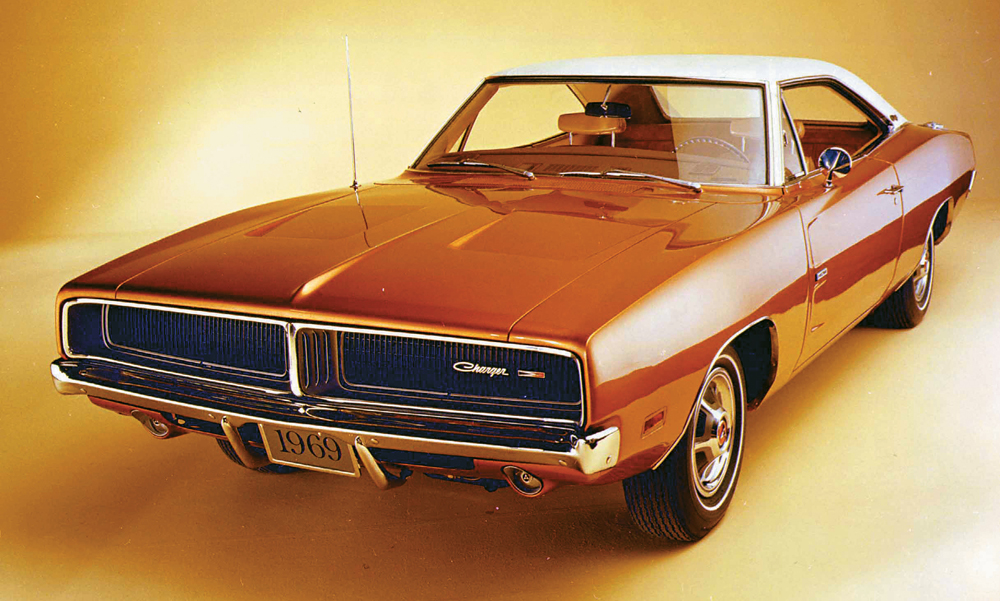
1969
The new second-generation Dodge Charger was a sales success, with a 343 percent sales increase compared with the 1967 model. With this success also came fame, and in 1968 the Dodge Charger made its film debut in the movie “Bullitt” starring Steve McQueen. The movie featured a black Dodge Charger R/T with a black vinyl top and the powerful 440 Magnum V-8 engine with a four-speed transmission.
Extensive use of wind tunnel testing and advanced research allowed Dodge Charger engineers to have a leg-up in NASCAR competition. As a consequence of aerodynamic testing — a first by any auto manufacturer in NASCAR — development and implementation of a rear spoiler and front air dam were added to Dodge Charger race cars to increase down force on the track.
Keeping the second-generation Dodge Charger fresh, the 1969 model year featured several evolutionary styling changes, including a revised front grille with a center divider, which created two smaller symmetric rectangular grilles. Round turn signals and tail lamps were replaced with rectangular units.
In an effort to give the 1969 Dodge Charger more personality, the Special Edition (SE) package was brought to market. This package included leather and vinyl seating options, wood grain trim, deep-dish wheel covers, hood-mounted turn indicators, and “Special Edition” badging on the C-pillars. This package was available on all models and would be the only year it would also be available on the base vehicle.
A late 1969 model year introduction was the Performance Hood option that consisted of bold graphics that clearly called out a “426 HEMI” or “440 Six-pack” engine under the hood. (Later model year Dodge Chargers featured performance hoods with functional hood scoops and air dams that allowed cool air to be drawn into the engine. The result was an improvement in performance and horsepower. These functional performance hoods featured manual controls often located on the instrument panel, allowing the driver to manually open and close the baffles as needed.)
From a powertrain perspective, the 225 cubic-inch “Slant Six” became the standard engine. It delivered 145 horsepower. During the 1969 model year, fewer than 2 percent of all Dodge Chargers were produced with the 426 HEMI V-8 engine, yet it contributed immensely to the lineup’s performance image.
The 1969 Dodge Charger gained fame as the tire-squealing getaway car driven by Bo and Luke Duke for seven seasons on the TV series, Dukes of Hazzard.
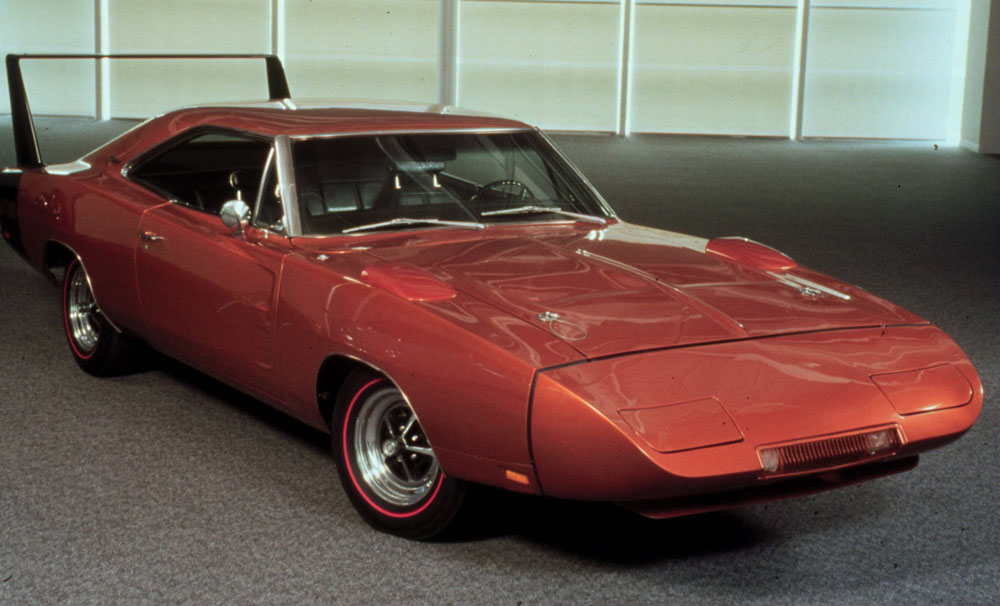
Continuing to pioneer aerodynamic development, the new 1969 Dodge Charger 500 model was introduced solely for NASCAR with a flush rear window for a reduced drag coefficient. Taking aerodynamic design and engineering to new heights, Dodge introduced the Charger Daytona model. The Dodge Charger Daytona featured a large aerodynamic nosepiece along with a huge winged spoiler that stood 58 inches above the base of the trunk. All Dodge Charger Daytona models were powered by the 440 Magnum or 426 HEMI engine. The Dodge Charger Daytona won its first NASCAR Grand National race at Talladega (Ala.) followed by a win at Texas International Speedway. From September 1969 into the following year, Dodge Charger 500 and Charger Daytona race cars combined to win 45 out of the next 59 races in NASCAR.
The Dodge Charger 500 and Charger Daytona eventually forced NASCAR to implement power restrictions on HEMI-equipped Dodge Charger race cars. To restrict engine power, NASCAR used carburetor restrictor plates on the HEMI engine and limited its engine displacement to a maximum of 305 cubic-inches on Charger Daytona models.

ON THE STREET… The 1969 Dodge Charger body style carried over from 1968 with minor exterior changes like a new grille and taillamps. The HEMI engine was installed in less than two percent of ’69 Dodge Chargers, yet contributed immensely to the image and desirability of the Charger lineup. The 1969 Charger gained fame as the tire-squealing getaway car driven by Bo and Luke Duke for seven seasons on the TV series, Dukes of Hazzard.
AT THE TRACK… The 1969 Dodge Charger 500, featuring a flush rear window to improve aerodynamics, was introduced especially for NASCAR. The Charger Daytona was introduced in September and built specifically for NASCAR competition. The Daytona featured a large aerodynamic nose and a huge “wing” spoiler in the rear that stood 58 inches above the trunk. All Dodge Charger Daytona models were powered by either a 440 Magnum cid or 426 HEMI engine.
Dodge Charger Daytona won its first NASCAR Grand National race at Talladega (Ala.) in September followed by a win at Texas International Speedway. From September 14, 1969, through the next year, Charger Daytona and the Charger 500 won 45 out of the next 59 races. The car dominated racing so much that NASCAR eventually placed restrictions on the HEMI engine by forcing the use of carburetor restrictor plates on Chrysler models featuring the HEMI engine and limiting engine displacement to a maximum of 305 cubic inches on Charger Daytona and Plymouth Superbird models.
Driver Buddy Baker, behind the wheel of a HEMI-powered Charger, became the first to top the 200 mph mark on a closed-circuit course in 1970.
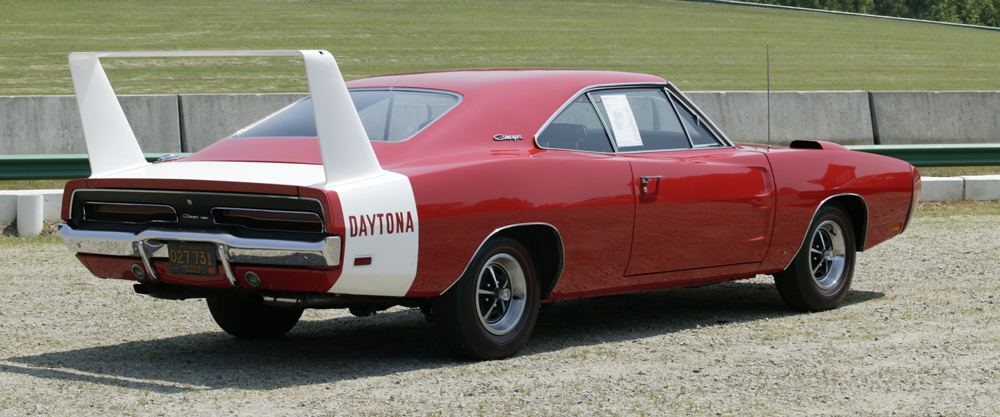
1969 Dodge Charger Daytona, Only 505 units were built of the Dodge Charger Daytona for model year 1969. it was the most conspicuously styled Dodge of all times and served as homologation model for the Dodge stock cars entered in NASCAR* races; it was available at a price of 3,860 US dollars. The road-going version of the model was powered by the Hemi 426 (seven liters) with 425 hp; the tuned racing version reached speeds in excess of 200 mph (over 320 km/h) on oval racetracks. *NASCAR: National Association for Stock Car Auto Racing
For NASCAR racing, Dodge resurrected the hemispherical-head concept in a new 426-cubic-inch HEMI-Charger engine for competition use only, which soon proved capable of generating some 500 horsepower. A special Daytona Charger race car equipped with a HEMI-Charger, an elongated nose piece and a roof-high spoiler attached at the rear took the checkered flag at the 1969 Daytona 500.
America’s fondness for fast cars was effusively addressed by Dodge during the “muscle car” era of the late ’60s and early 1970s. Placing large V-8 engines in intermediate-size cars with optional levels of accessorizing brought drag strip-style performance to street racers and distinctive collector cars to thousands of other buyers. Notable Dodge nameplates from the muscle car period include the Charger R/T (for Road and Track), the Coronet R/T, with a 440-cubic-inch Magnum V-8 engine as standard equipment, the Super Bee and, after 1970, the Challenger.
The effects of the 1973 oil crisis, which spawned skyrocketing prices for both crude oil and retail gasoline, were new government emissions regulations and rising insurance rates that combined to bring the muscle-car era to a close and generate new interest in smaller, more fuel-efficient cars. Dodge responded with the subcompact Omni, one of the first American-made cars with front-wheel drive.
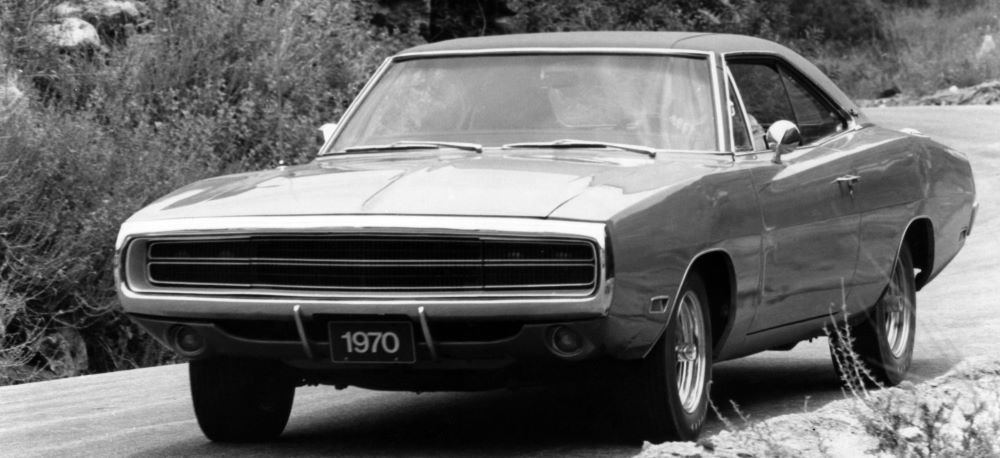
1970s
NASCAR was not the only force curbing the performance of muscle cars. By 1970, government and insurance companies regarded muscle cars as “high risk” vehicles.
Dodge Charger received another set of minor styling changes for 1970. The coupe now sported a full-width single opening grille, accented by a scripted “Charger” badge. Driver and passenger door scallops continued on all models, while the R/T model received rearward facing fiber glass scoops with a large “R/T” emblem. Additional customization options included a redesigned rear Bumble-Bee stripe that was changed to a single solid line design available in 18 accent colors.
New for the 1970 Dodge Charger base model was a split-back vinyl bench seat, while the Charger R/T and 500 models continued with sport bucket seats. Minor modifications were also made to interior door panels and included the “Charger” script badging.
- Only three Dodge Charger trim levels were offered in 1970 — base, R/T and 500 — which was now only related to its racing ancestor through name.
- On the track in 1970, racecar driver Buddy Baker became the first to top the 200 mph mark behind the wheel of a HEMI-powered Dodge Charger. The feat was accomplished on a closed-circuit course.
- Bobby Issac won the NASCAR championship driving a Charger 500 and Daytona, including 27 records at Bonneville using the Daytona.
ON THE STREET… The Dodge Charger was completely redesigned for the 1971 model year with a shorter wheelbase and wider body style. A modern, sleek and sporty design evolved with a swept back roofline and semi-fastback. A front spoiler and a “Ramcharger” vacuum-operated hood scoop were added.
The Charger Super Bee performance package was introduced to the lineup in addition to the R/T performance model. Charger now had four price classes and two performance models.
Due to increasing emissions and insurance regulations, the industry moved to low-lead gasoline, and the Street HEMI was phased out. 1971 was the last year customers could order a factory-built HEMI.
In 1975, the Dodge Charger was completely restyled and featured a more formal and elegant appearance. The largest engine available was the 360 cid. By 1978, the rear-wheel-drive Charger was phased out of the Dodge lineup.
AT THE TRACK… The Dodge Charger Daytona entered the Daytona 500 with 305-cubic-inch engine and driver Dick Brooks at the wheel. The vehicle qualified for the race and even led for a time, but in the end, managed to place only seventh. This was the last of the Dodge Daytona models to race at Daytona.

1971-1974
(Generation: III)
The all-new third-generation Dodge Charger featured a 2-inch shorter wheelbase, while its overall length decreased by 3 inches. With two unique floor pans, the 1971 Dodge Charger created the basis for the replacement of the Dodge Cornet coupe. Designers and product planners believed combining both nameplates with a common architecture would provide four-door customers better legroom, while delivering sporty coupe styling that enthusiasts craved. Dodge enthusiasts worried that this third-generation Dodge Charger would ruin the legendary nameplate, but the 1971 model went on to outsell the original version.
The restyled 1971 Dodge Charger featured many design cues from the original model, while the overall appearance was more contemporary. Its coupe design evolved into an integrated and sleek look with a semi-fastback roofline and body-color wrap-around bumpers available on new Dodge Charger R/T and performance Super Bee models.
High-performance cars were becoming less popular, and 1971 would be the last model year for a hardcore performance-equipped Dodge Charger. In response to stricter government regulations on insurance, fuel economy and emissions, the Dodge brand offered the Charger with the respectable performing 340 cubic-inch engine, the 225 cubic-inch Slant Six, a 318 cubic-inch V-8 and a 383 cubic-inch engine available in two- or four-barrel configurations. In keeping with the Dodge Charger’s performance tradition, a new “Ramcharger” vacuum-operated hood scoop was available and provided cooler ambient air into the engine for improved power and performance.
Due to increasing emissions and insurance regulations, the automotive industry moved to low-lead gasoline, and the HEMI engine was phased out in 1971. This was the last year customers could order a factory-built Dodge Charger equipped with a HEMI.

The 1971 Dodge Charger model lineup was expanded to six models: base, hardtop, 500, SE, R/T, Super Bee and a Road Runner imitation that was positioned as a Dodge Charger street racer.
Since there was no longer a unique Dodge Cornet model, a de-contented entry-level model Dodge Charger was added and featured a basic instrument panel and vinyl bench seats.
Aligning with changing customer demands, the 1971 Dodge Charger 500 was repositioned in the lineup to deliver more performance styling than actual performance. This would be the final year of the Dodge Charger 500.
Dodge brand’s biggest seller in 1971 was the Charger SE. This model was equipped with many of the features from the previous Dodge Charger SE, but replaced bucket seats with cloth and vinyl split-back bench seats. Other features that were added to the vehicle included an ignition lock, chromed pedals and an inside hood release. Available powertrain options for this volume model included the 318 cubic-inch V-8 engine all the way up to the 440 Magnum V-8 engine (The 440 Six Pack and HEMI V-8 engines were not available on the SE model).
The 1971 model year would also be the last appearance of the Dodge Charger R/T model. The Dodge Charger R/T was distinguished by its louvered dome hood with flat black accent paint and “R/T” logo decal. Additional features included bold horizontal bodyside stripes, heavy-duty suspension and 440 Magnum V-8 engine with a column-mounted shifter (a manual floor mounted shifter was available as a no-cost option).
On the track in 1971, the Dodge Charger Daytona entered the Daytona 500 with a 305-cubic-inch engine with driver Dick Brooks at the wheel. The vehicle qualified for the race and even led for a time, but in the end, managed to place only seventh. This would be the last Dodge Daytona model to race at Daytona.
As muscle cars were falling in popularity, the high-performance Dodge Charger R/T and Super Bee models were dropped, while a new Rallye package was added for 1972. The new Rallye package continued to position the Dodge Charger as a muscle car with its sculpted grille, scalloped doors, black-out tape and multi-louvered tail lamps (inspired by earlier Dodge Charger models) but lacked the hardcore performance muscle-car enthusiasts craved. In reality, the new Dodge Charger Rallye package delivered better handling than the previous year’s Dodge Charger R/T.
Exterior updates for the 1972 model year included the addition of hidden flip-up headlamps on the Dodge Charger SE and a new vinyl-covered roof. This model year also offered up to 18 exterior colors, including high-impact colors: Hemi Orange and Top Banana.
Finishing the 1972 model year, three specialty packages were added to the Dodge Charger SE lineup as a dealer incentive. The popular and highly contented “A07” package included power steering, power front-disc brakes, AM radio with rear speakers, variable-speed wipers, air conditioning, electrical clock, tinted glass, rear-window defogger and the Brougham package. These “luxury Chargers” were far more popular than the Dodge Charger SE Topper and Topper X packages that also were available.

By 1973, Dodge Charger was the brand’s second best-selling model (behind the Dodge Dart). Important model updates included an increase in overall length by 7 inches (mostly gained in the rear quarter panels), a new crosshatched-pattern front grille and multi-louvered tail lamps. A new roof design with movable rear-quarter windows allowed for new canted louvers to give Dodge Charger a sportier look. At the end of the model year, a no-cost “halo roof” option featured a vinyl roof that did not extend as far down the body side of the coupe.
Powertrain options for the 1973 Dodge Charger models were similar to the previous year. The entry-level Dodge Charger continued with the 225 cubic-inch six-cylinder engine that delivered 105 horsepower. The Dodge Charger SE and Rallye package coupes featured the 318 cubic-inch V-8 engine. Engine options included the 340 cubic-inch V-8, the 400 cubic-inch V-8 available with a two- or four-barrel carburetor and the de-tuned 440 cubic-inch four barrel V-8 (which lost its Magnum status for 1973).
The 1974 Dodge Charger would be the last model year that had any enthusiast appeal or performance. The success of the luxurious Dodge Charger SE of late 1972 and 1973 caused the Dodge brand to neglect marketing models like the Dodge Charger Rallye.
No longer a powerful and nimble performance coupe, the 1974 Dodge Charger grew one more time to implement new federally mandated 5 mph impact standards, while its powertrain options carried over from the previous year.
Matching the now comfort-over-performance coupe was the introduction of Dodge Charger “Spring Special,” which included earthtone paint colors like Sienna Metallic, Black Parchment and Dark Moonstone. Topping off the more luxurious look was an elegant body-side stripe in Parchment Brown. Inside these special models received unique interior surfaces in cloth and vinyl.

1975- 1978
(Generation: IV)
With the oil embargo and fuel shortages, fuel economy took priority over performance, and the all-new fourth-generation Dodge Charger was far from the aggressive coupes offered in the late 1960s.
With more than 55 percent of Dodge Chargers sold in 1974 as SE models, the 1975 Dodge Charger was completely restyled and featured a more formal and elegant appearance. Based on the Chrysler Cordoba, the new Dodge Charger SE (only model available in 1975) shared nearly identical styling cues. The face of the new coupe featured two single headlamps set into the body with corresponding hood-forms for an integrated look. Overall design elements focused on luxury and included a vinyl roof, wire-spoke hubcaps, plush vinyl bucket seats, center armrest and the availability of premium cloth seats for an upscale look and feel.
Powertrain choices for the 1975 Dodge Charger SE consisted of a 360 cubic-inch V-8 engine, a 318 cubic-inch V-8 engine and, later, a 400 cubic-inch V-8 engine with either two- or four-barrel carburetor.
Hoping to revive the Dodge brand and Charger nameplate with more excitement, the Daytona model returned for the 1976 model year. While the Dodge Charger Daytona was a NASCAR legend, the new model was more like a two-toned Dodge Charger SE.
Minimal interior and exterior changes made the 1976 Dodge Charger a carry-over model. One additional change to the lineup included new Dodge Charger base and Sport models, which in reality fused the Dodge Cornet models back into the Dodge Charger lineup again.
The Midnight Charger Special was the highlight of the 1977 model year and featured an array of different design elements, including a unique plastic front fascia with body-color grille, body-color exterior racing mirrors and open air T-top roof with removable roof panels. Leather-trimmed seating was standard inside this special edition Dodge Charger.
Dodge Charger SE and the two-tone Dodge Charger Daytona, now with large body-side decals, were the only two models left. The Dodge Charger base and Sport models were replaced with the new Dodge Monaco, simply a renamed Dodge Coronet-based coupe.
The last year for a rear-wheel-drive Dodge Charger was 1978. The Dodge Charger Daytona was dropped from the lineup and minimal changes were made to the Dodge Charger SE. But the Dodge brand gave one last effort with the introduction of a new sporty model dubbed the Dodge Magnum XE. This new Dodge Charger-based coupe featured a slightly flared body side, horizontal three bar grille and rectangular flip-up quad headlamps.

Dodge Charger in NASCAR: 1966-1977
Total Dodge Charger Wins: 124 (six earned in winged Charger Daytonas)
Most Charger Wins by a Driver:
- Richard Petty – 37
- Bobby Isaac – 36
- David Pearson – 17NASCAR Drivers Who Won in a Dodge Charger:
- Earl Balmer – (1966)
- Charlie Glotzbach – (1968, 1970)
- David Pearson – (1966-67)
- Richard Brickhouse – (1969)
- Sam McQuagg – (1966)
- Ray Elder – (1971-72)
- LeeRoy Yarbrough – (1966-67)
- Richard Petty – (1973-77)
- Bobby Allison – (1967, 1969-71)
- Dave Marcis – (1975-76)
- Buddy Baker – (1967-68, 1970-73)
- Neil Bonnett – (1977)
- Bobby Isaac – (1968-1972)NASCAR Drivers Who Drove a Charger During a Championship Season:
- David Pearson – (1966)
- Bobby Isaac – (1970)
- Richard Petty – (1972, 1974, 1975)
First Dodge Charger NASCAR Win: Earl Balmer, Feb. 25, 1966, Daytona International Speedway, (40 laps/100 miles/2.5-mile track) – Balmer led one lap en route to winning the 100-mile qualifying race in a No. 3 Dodge Charger owned by Ray Fox.
WINGED WARS: Sept. 14, 1969 – Richard Brickhouse’s No. 99 Nichels Engineering Dodge Charger Daytona (originally to be driven by Charlie Glotzbach) is the first “winged” stock car to win a NASCAR race. Brickhouse earns his first and only career victory amid a Professional Drivers Association boycotted Talladega 500 – the inaugural race at Alabama International Motor Speedway.
200.447 MPH: March 24, 1970 – Buddy Baker becomes auto racing’s first driver officially timed completing a closed-course lap at more than 200 miles per hour. Baker piloted his Cotton Owens-owned No. 88 Dodge Charger Daytona to a top lap speed of 200.447 mph at Talladega Superspeedway.
Dodge Charger in NASCAR: 1966-1977
Most Recent Dodge Charger NASCAR Win: Neil Bonnett, Nov. 20, 1977, Ontario Motor Speedway (200 laps/500 miles/2.5-mile track) – Bonnett drove the No. 5 Dodge to victory in the season-ending Los Angeles Times 500, leading eight times for 96 laps in his first superspeedway win. Bonnett passed Richard Petty with five laps to go, blocking Petty’s last-lap maneuver to win by two car lengths.
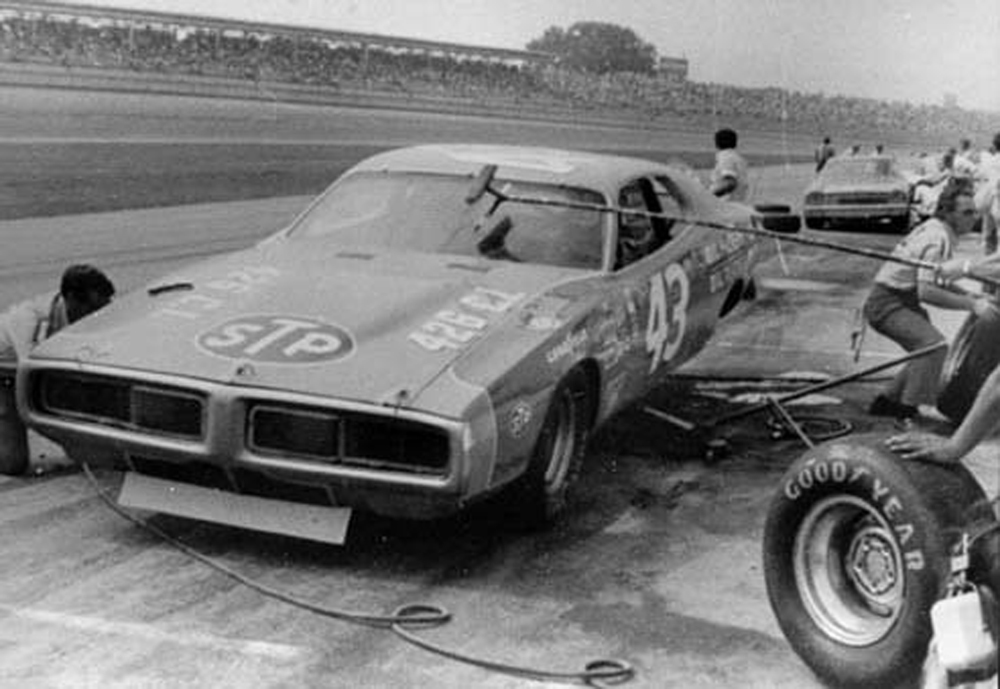
1969 Dodge Charger Daytona – window sticker
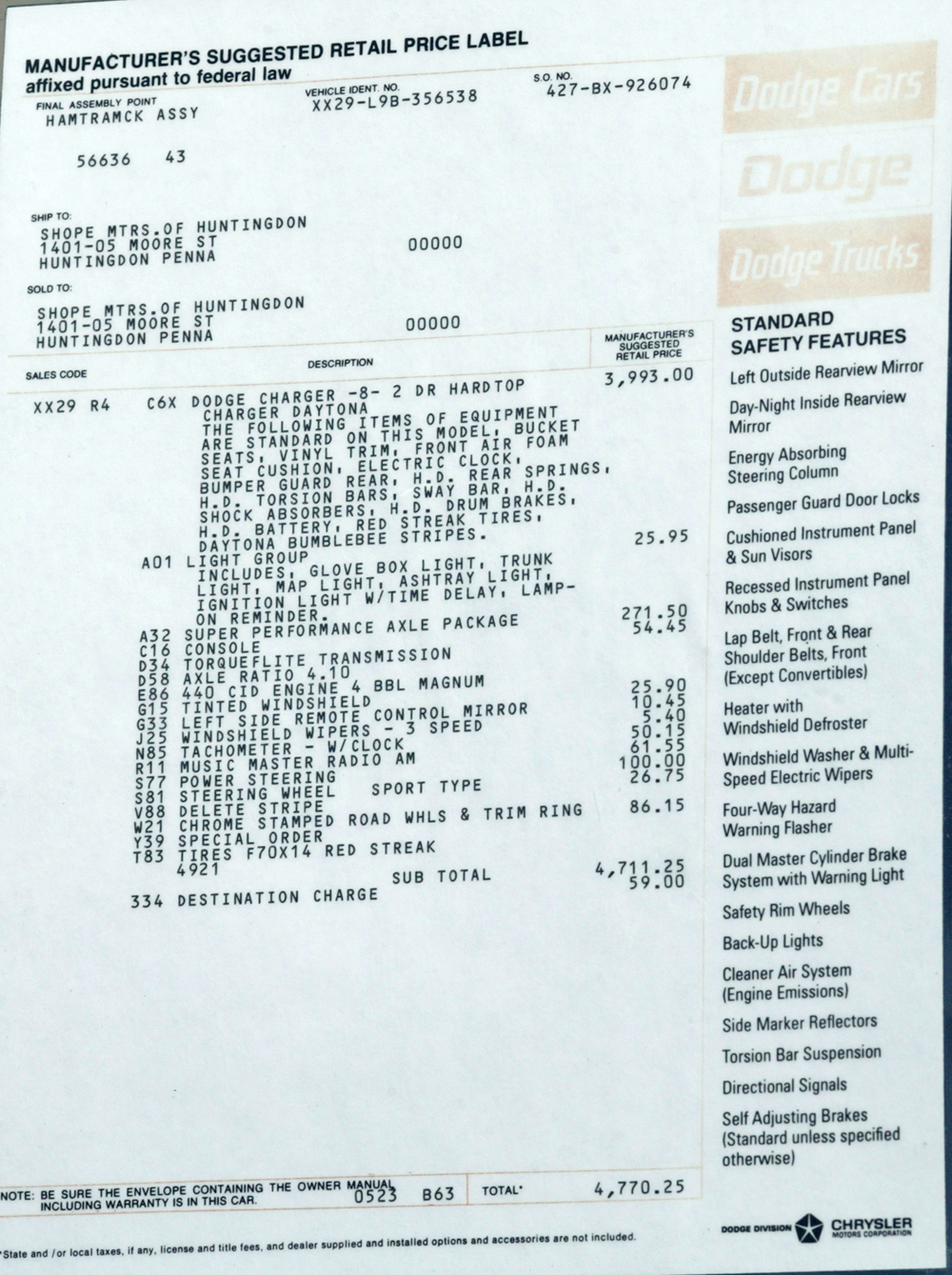

You must be logged in to post a comment.